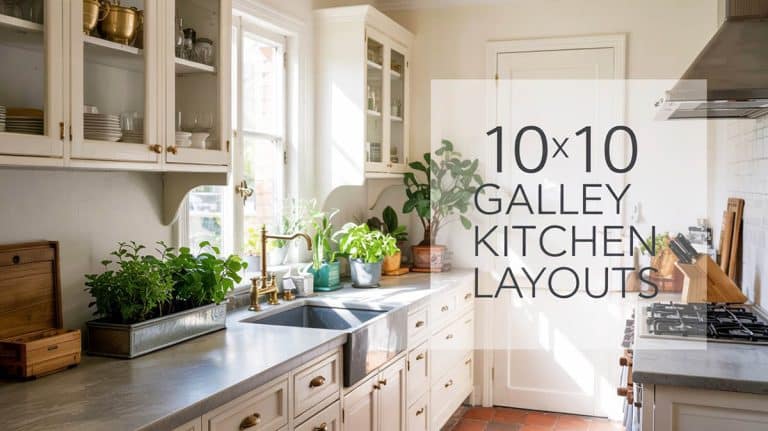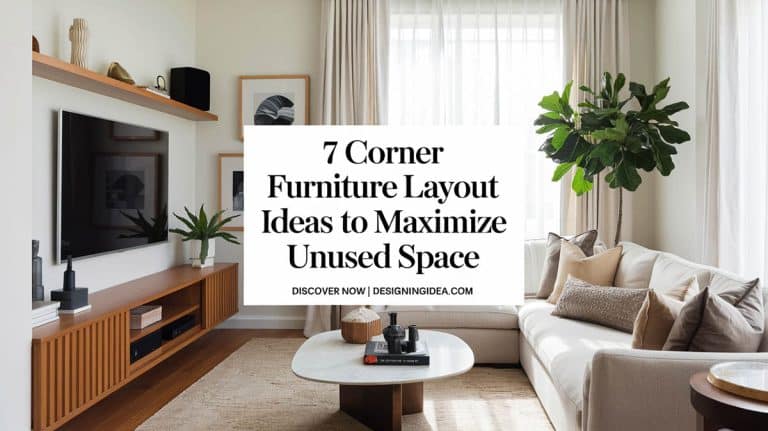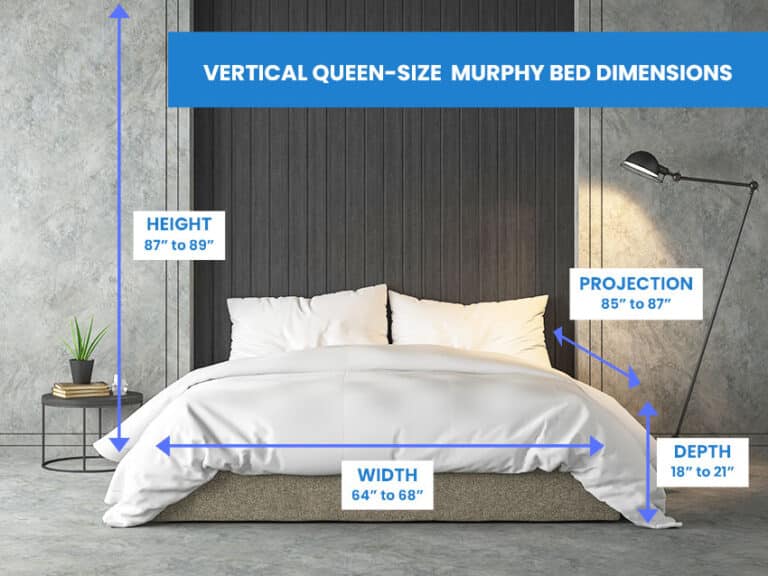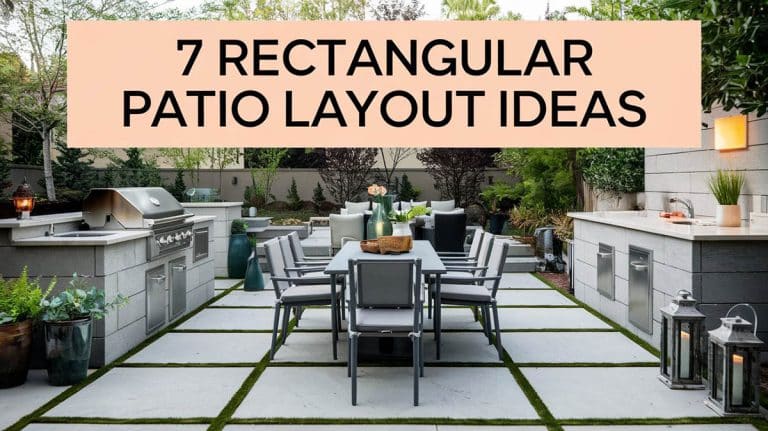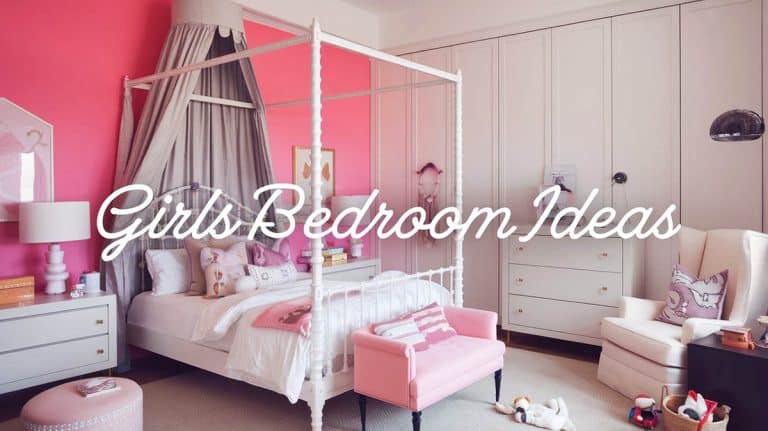9 Kids Bedroom Layout Designs That Parent Will Love
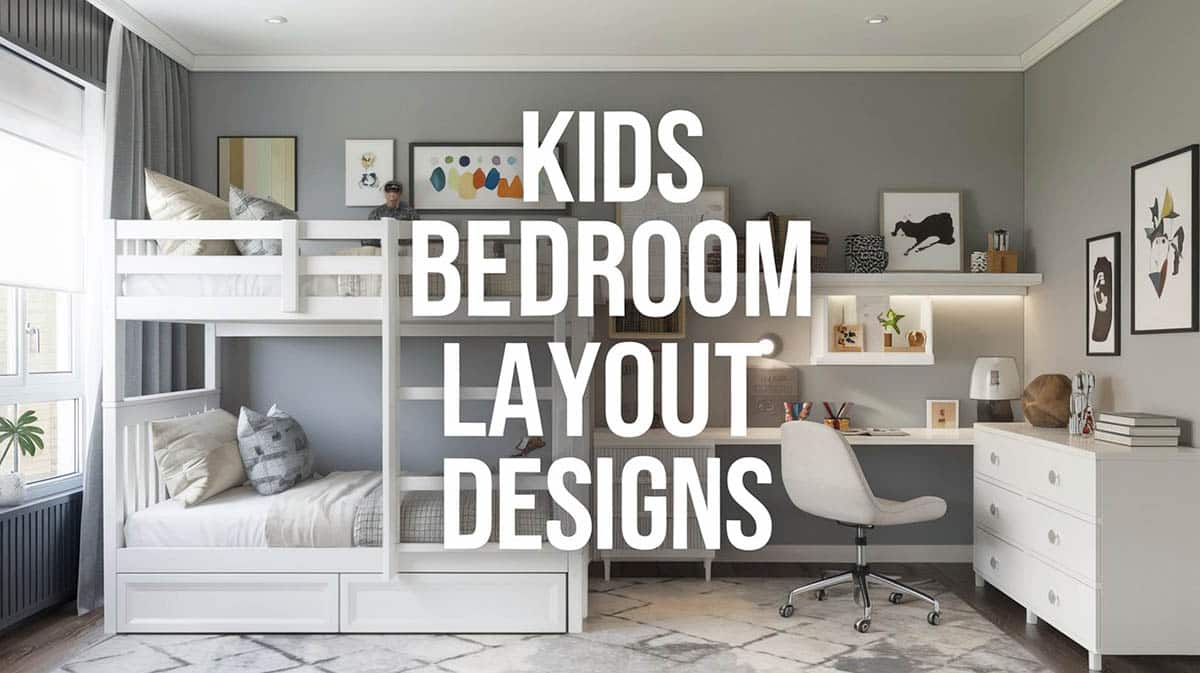
Designing a kid’s room can feel like a puzzle to fit all the elements, such as the bed, desk, storage, and play space, together. This guide offers 9 kids’ bedroom layout designs that strike a balance between fun and function for every age, from toddler play areas to tween study zones and sibling setups. Each floor plan shares you where everything goes, with walkways, storage, and bed arranged with the exact dimensions to use so the room grows with your child. Let’s explore and pick a plan that fits your space, to create a bedroom that your kids and you will love.
Kids’ Bedroom With Twin Bed And Study Area Layout
With a large central area, this bedroom layout is effective because it provides dedicated space for sleeping, studying, and storage around the room’s edges.
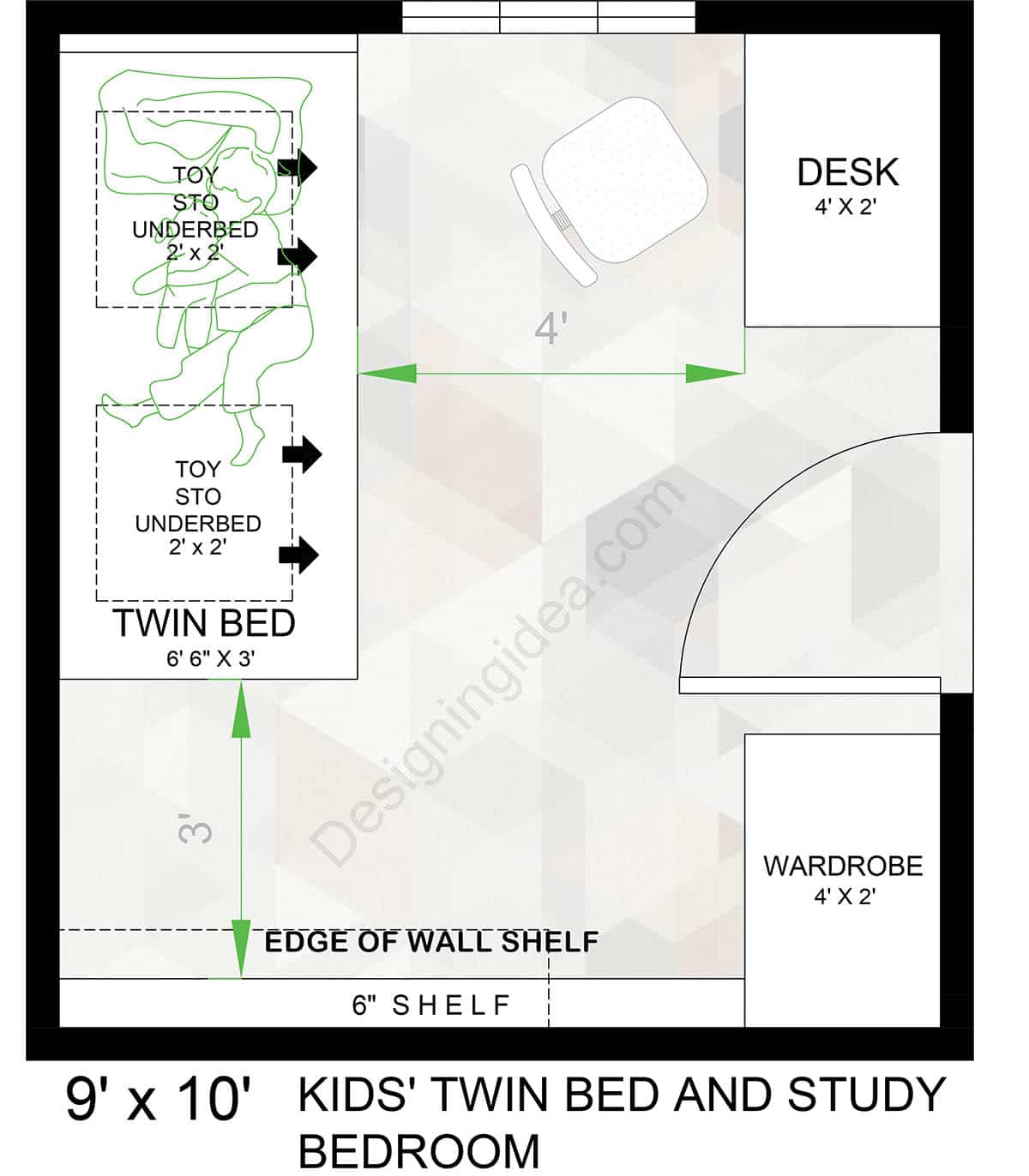
Floor Plan Details: This compact layout splits the room into clear zones, with the sleep area on the top left, study zone on the top‑right corner, and storage near the entry door. A twin bed runs head‑to‑toe along the left wall with two pull‑out 2′ × 2′ under‑bed toy bins to help reduce clutter. There’s 3′ of clearance at the bed’s foot for dressing and circulation. Opposite the bed, sits a 4′ × 2′ desk by a window so the work area benefits from natural light. A 4′ × 2′ wardrobe is placed next to the entry, and a low 6″‑deep wall shelf is installed along the bottom wall to keep books and small toys arranged and accessible. The final result is a kid-friendly bedroom with a central open space for play.
Dimensions:
- Room size: 9′ × 10′
- Twin bed: 6’‑6″ × 3′
- Under‑bed toy storage (2 units): 2′ × 2′ each (pull‑out)
- Desk: 4′ × 2′
- Wardrobe: 4′ × 2′
- Central clear aisle (bed to desk): 4′
- Clearance at bed foot: 3′
- Wall shelf depth: 6″
Design Tips:
- Use the under bed space for storage. Use rolling bins for the 2′ × 2′ under‑bed cubbies so kids can pull them into the aisle when it’s time to play.
- Hang a pegboard or bulletin board over the desk. Mount a peg rail over the 4′ desk to keep the surface clear, or opt for a bulletin board for personalization.
- Choose a task light + blackout shade. Place these at and near the desk window to balance lighting with sleep needs.
- Install a long shelf. Keep the 6″ shelf at 36–42″ height to act as a picture ledge or book rail.
- Add door‑back hooks. This is useful next to the wardrobe for backpacks or jackets.
- Add an area rug. A 4′ × 6′ rug, centered in the aisle, defines the play space and softens the sound during playtime.
- Plan outlets/USBs at desk height. This is helpful for electronics, like devices or a cooling fan, to be kept at the desk and away from the bed.
Shared Sibling Bedroom (Two Twin Beds) Floor Plan
Symmetry plays a significant role in this shared bedroom design, which allows two kids to comfortably sleep on one side and study in an organized space along the opposite wall.
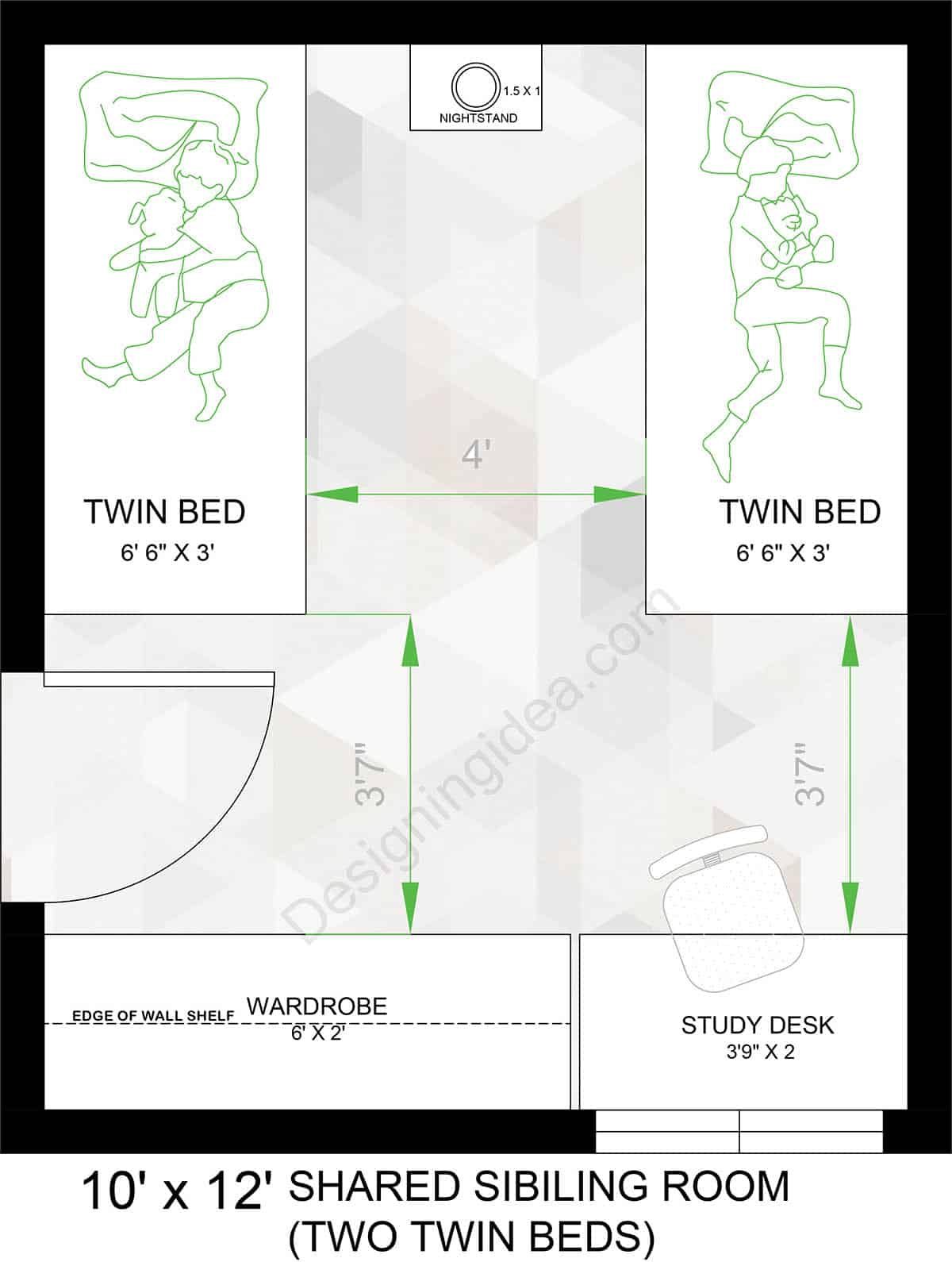
Floor Plan Details: This balanced layout gives each child their own bed, while keeping the center open and leaving a shared study desk and wardrobe on the opposite side. Two twin beds (heads on the top wall) face the room with a shared nightstand with a single lamp between them. A 4′ gap separates each bed and creates a play lane and space for easy bed‑making. Along the bottom wall, the left side holds a 6′ wardrobe (with a shallow wall shelf above), and on the right side is a shared study desk beneath a window. The door swings open in the middle left, and doesn’t conflict with furniture or the main center walkway.
Dimensions:
- Room size: 10′ × 12′
- Each twin bed: 6’‑6″ × 3′
- Space between bed ends: 4′
- Nightstand (between headboards): 1’‑6″ × 1′
- Wardrobe: 6′ × 2′
- Study desk: 3’‑9″ × 2′
- Clear walkway from storage/desk to bed ends: 3’‑7″ (on both sides)
Design Tips:
- Use matching under‑bed drawers or bins. This can help enhance the storage without narrowing the center lane.
- Mount individual sconces above each headboard. This way, siblings can control their own reading lights.
- Install a top shelf and double hanging rods on the 6′ wardrobe. You can assign the left and right sides to each child.
- Keep the nightstand shared. This helps to reduce clutter and create a central fixture.
- Choose a 5′ × 7′ area rug. Center it in the middle of the 4′ lane.
- Place over‑the-door hooks. They can be used to hang backpacks and jackets to keep them off the floor.
Bedroom With Bunk Bed And Play Area Layout
This design works by moving the sleep, study, and storage areas to the perimeter of the room so there’s a roomy 4’‑wide central play zone that promotes an open feel.

Floor Plan Details: This layout reserves the center of the room as an open play area, featuring a twin-sized bunk bed in the top left corner. With the twin‑over‑twin bunk bed using the same footprint as a regular twin, there’s room in the opposite corner for a 4′ × 2′ desk with a large 5′ aisle. Sharing the same wall as the desk, sits a 3′ × 2′ wardrobe with a window in between and a 4′ wide open area designated for play. An L‑shaped 1’‑deep wall shelf in the upper‑right corner provides storage for books and bins without eating into the available floor space.
Dimensions:
- Room size: 10′ × 11′
- Bunk bed footprint: 6’‑6″ × 3′
- Desk: 4′ × 2′
- Wardrobe: 3′ × 2′
- Central play‑area width (desk to wardrobe): 4′
- Left‑side aisle for chair/traffic: 5′
- Wall shelf depth: 1′ (corner run)
Design Tips:
- Choose a bunk with ladder on the foot (not the side.) This helps keep the 5′ aisle open
- Add safety and usability features to the bunk bed. Add full‑height guardrails and a clip‑on reading light per bunk for the top sleeper.
- Use a flush‑mount ceiling light. This will brighten the active zone.
- Add a 5′ × 7′ rug. Center this in the play area to soften the floor and designate the zone.
- Mount cord‑free blinds. This can help to avoid anyone from tripping in the play lane.
- Put toy bins on the 1′ wall shelf. Keep lighter items up top and reserve the lower wardrobe section for daily clothes.
- Add magnetic/peg board above the desk. This makes it easy to find what kids need without cluttering the work surface.
Kids Loft Bed With Study Space Bedroom Design
With a sleep-over study style loft bed, one can free up floor space, delivering a tidy, kid-sized workstation and plenty of free open floor space.
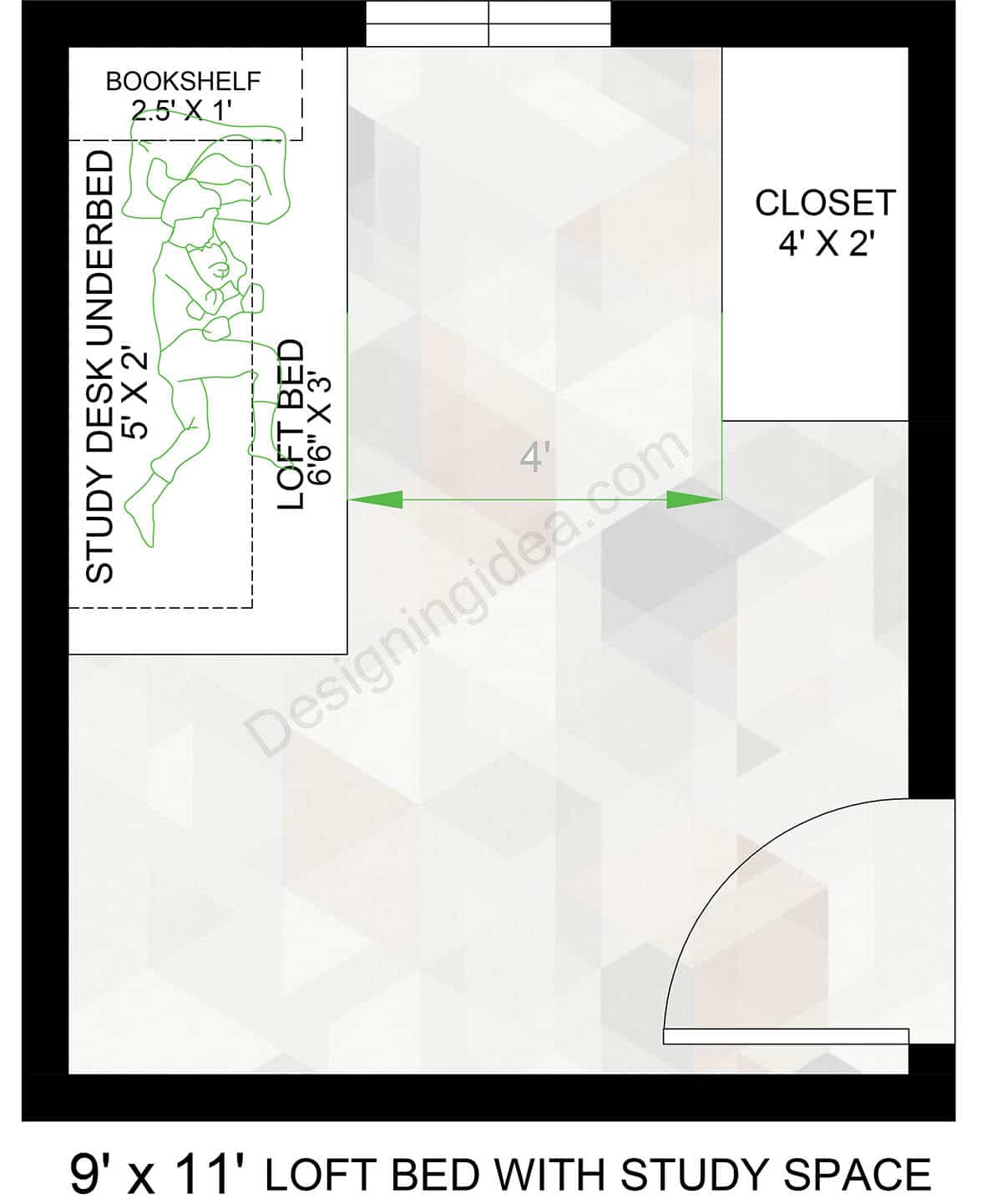
Floor Plan Details: This space‑saving bedroom layout positions a loft twin bed (6’‑6″ × 3′) with a 5′ × 2′ desk tucked underneath to create an effective work study corner. This dedicated homework nook allows for a 2.5′ × 1′ bookshelf at the head end for books and bins. On the opposite side sits a 4′ × 2′ closet near the door to consolidate clothing storage. The plan preserves a 4′ central aisle between the study side and closet, so nothing feels crowded.
Dimensions:
- Room size: 9′ × 11′
- Loft bed footprint: 6’‑6″ × 3′
- Under‑loft study desk: 5′ × 2′
- Bookshelf: 2.5′ × 1′
- Closet: 4′ × 2′
- Central clear aisle: 4′
Design Tips:
- Add hard‑mounted LED strips under the loft bed. Led lights will help brighten the desk and attach a clip lamp at the headboard for bedtime reading.
- Add an outlet strip with cord clips at the bed. This will ensure plenty of outlets for work with electronics at the desk.
- Choose a ladder at the foot (or end) of the bed. This will keep the desk face open.
- Use a rolling pedestal (15–18″ deep) under the desk. This is useful for storing school supplies.
- Attach a cork/peg board underneath. This is useful for important dates, memos, or to-dos.
- Center a 4′ × 6′ rug on the open area. Use this to define the play space and add some character.
- Fit the closet with double hanging rods and a high shelf. Helps to maximize the storage capacity.
Bedroom With Twin Bed, Storage And Reading Nook Floor Plan
Geared toward a perfect balance of rest, study, and storage space, this design combines a built‑in window‑seat nook with a compact desk wall and a corner bed while preserving easy movement throughout.
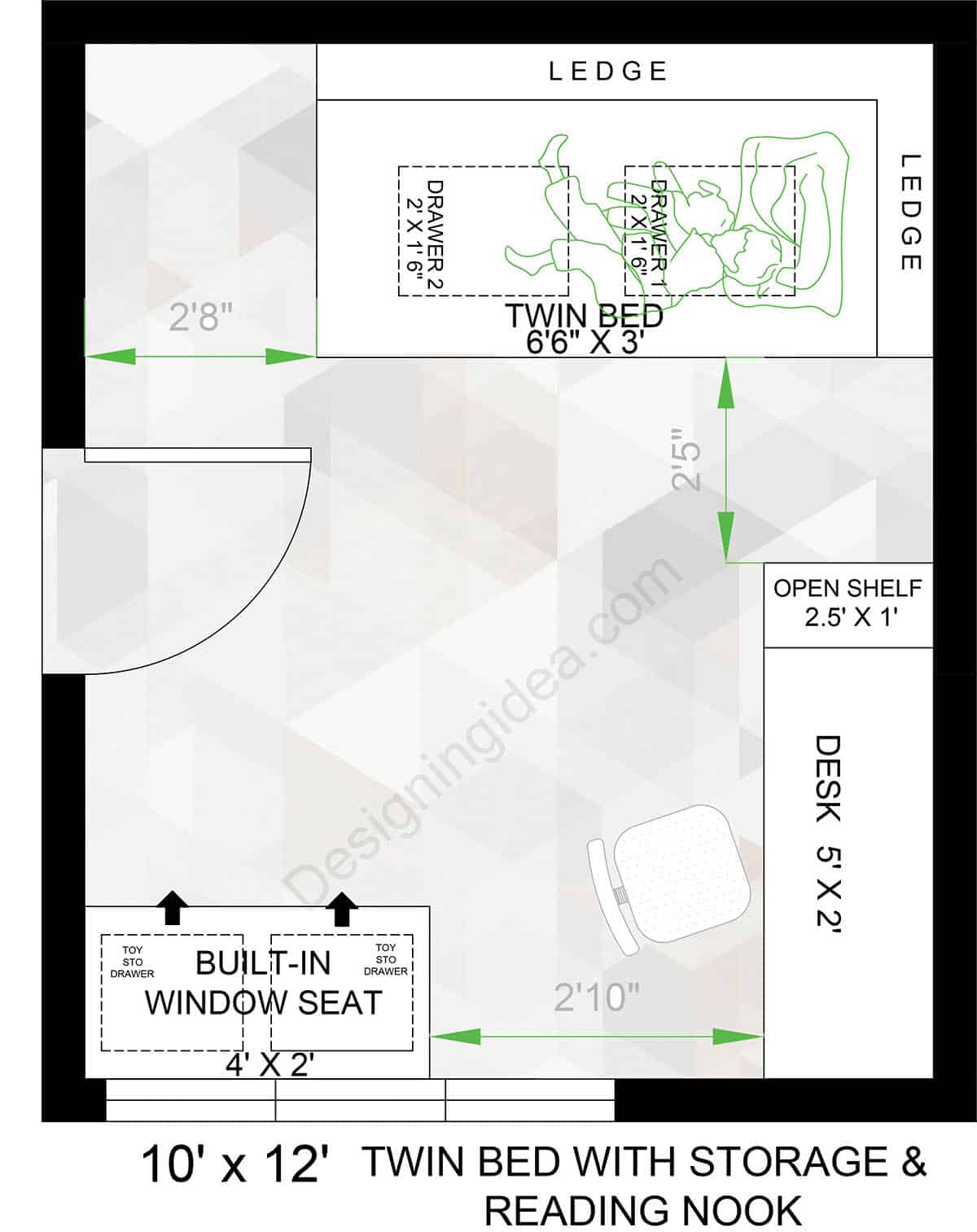
Floor Plan Details: This plan wraps the bed, storage and seating around the room’s edges to keep an open space in the middle. A twin bed (6’‑6″ × 3′) is placed along the top wall with two under‑bed drawers for storing toys or clothes. Above this is a shallow ledge of shelves for easy‑to-reach book rails. On the opposite side, a 5′ × 2′ desk makes up the study zone with a nearby open shelf (2.5′ × 1′) for books and bins. Under the window on the bottom wall, there’s a built‑in 4′ × 2′ window seat tht doubles as a reading nook with concealed storage drawers underneath.
Dimensions:
- Room size: 10′ × 12′
- Twin bed: 6’‑6″ × 3′
- Under‑bed drawers (2): 2′ × 1’‑6″ each
- Desk: 5′ × 2′
- Open shelf: 2’‑6″ × 1′
- Built‑in window seat: 4′ × 2′ (with storage drawers)
- Clearances: 2’‑8″ near the door side, 2’‑5″ between bed and desk, 2’‑10″ between window seat and desk
Design Tips:
- Use under‑bed drawers. This way, kids can access the toys easily and store them out of sight.
- Add a reading sconce and a firm bench cushion on the window seat. Adds a comfy place to curl up away from the desktop.
- Treat the ledges as shallow book and picture rails. Add a ½” lip so items don’t slide off.
- Mount a pegboard above the desk with a task light. Place these under the open shelf to keep the surface clear.
- Place a low‑pile 5′ × 7′ rug in the open floor area. Use this to define the play space.
- Include cord management at the desk. Consider a USB/charging outlet near the bed for electronics.
Bedroom With L-Shaped Bunk Bed And Play Area
Positioning the two beds in an L shape frees a full 6′ square of uninterrupted floor space, giving siblings room to play in the middle, while wardrobes and bin racks store clothing and items along the edges.

Floor Plan Details: This layout tucks two perpendicular twin beds into the upper-left corner to form an L-shaped bunk. Bed 1 runs up-down beside the door, while Bed 2 runs side-to-side along the upper wall. By clustering sleep zones in this way, it opens up a large 6′ × 6′ play area in the center of the room for building, reading, or dance-offs. Two 3′ × 2′ wardrobes line the bottom-left wall, creating a small dressing alcove. Stretching across the bottom wall to the wardrobes is a low 1.2′-deep, by 7′-long storage rack for toy bins that is paired with a shallow wall shelf for books and trophies.
Dimensions:
- Room size: 11′ × 13′
- Bed 1: 6′ × 3′
- Bed 2: 6′-6″ × 3′
- Central play area: 6′ × 6′
- Wardrobes (two): 3′ × 2′ each
- Storage rack for bins: 1.2′ × 7′
- Main walkway (door to play zone): 3′-4″
Design Tips:
- Ladder positioning at the foot. Use full-height rails on the upper bunk and place the ladder so it doesn’t stick out into the play area.
- Under-bed drawers. Slide 18 to 20″-deep drawers beneath Bed 1 to hide bedding and bulky clothes.
- Zone lighting. Mount a clip light on each bunk and install a flush-mount ceiling fixture directly above the 6′ play square.
- Color-coded bins. Label the 1.2′-deep rack of bins by the child’s name or toy type so cleanup is easier.
- Wall shelf safety. Keep the shelf 5 ft off the floor (above head height) to avoid anyone from running into it.
- Rug comfort. Add a 5′ × 5′ low-pile rug inside the play zone to define the activity hub.
- Door-back organizers. Hang fabric pockets for shoes or storybooks to save space.
Bedroom With Twin Beds And Built-In Desk Design
Balanced twin beds on opposite walls with an 8 built‑in desk and a 6 × 4 center rectangular space create a tidy, shareable room with defined study, sleep, and play areas.
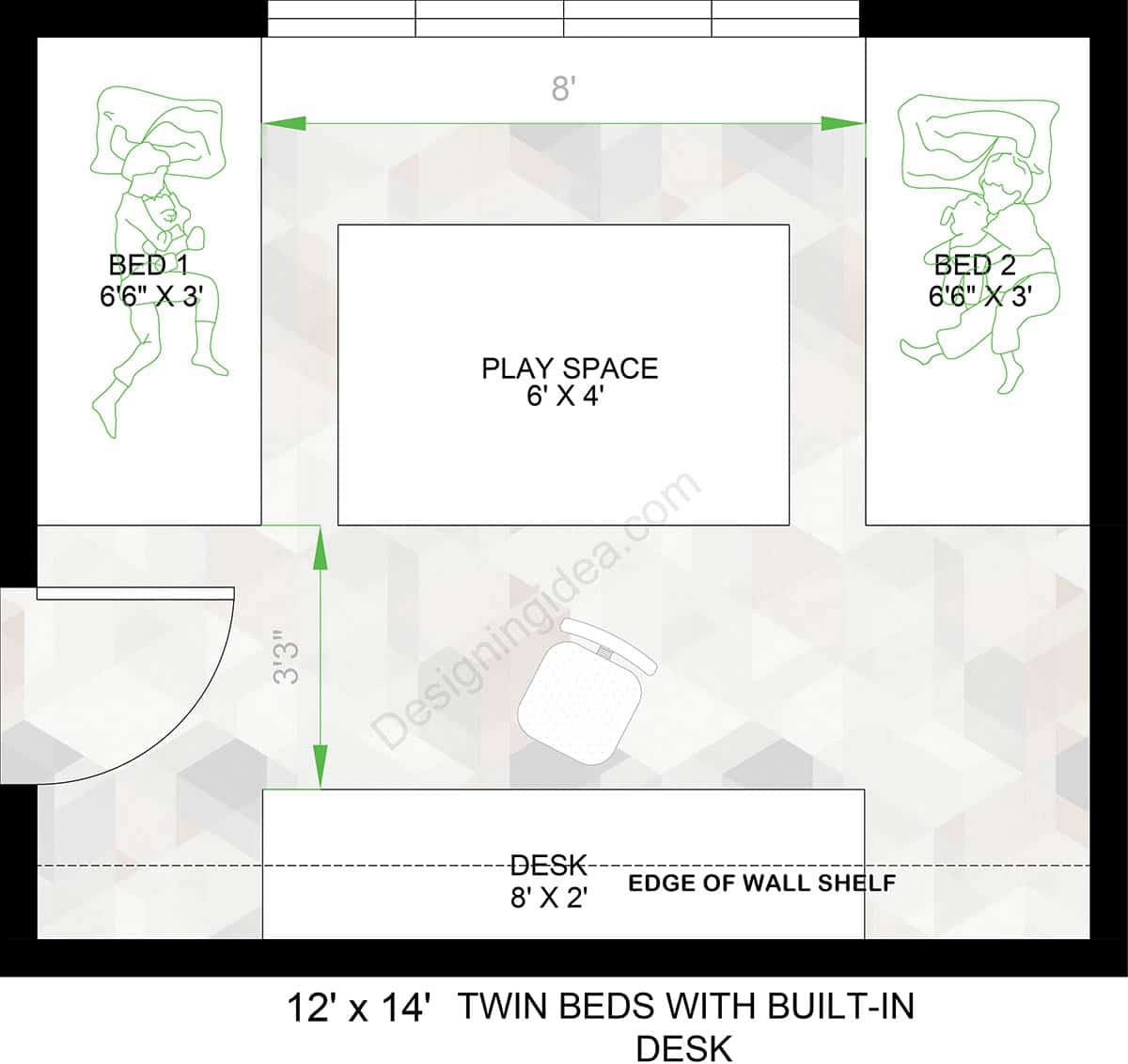
Floor Plan Details: This symmetrical layout gives each child their own dedicated side of the room, which works great for those looking for their independence in a shared space. Since both beds are pushed to the side there’s room in the center for a 6′ × 4′ play rectangle. Bed 1 and Bed 2 (both twin, measuring 6’‑6″ × 3′) sit along the left and right walls with a windowed top wall in between. This setup helps keep sightlines open and reduces bedtime collisions. The entire bottom wall is arranged as a study/storage area with an 8′ × 2′ desk and a shallow wall shelf above it.
Dimensions:
- Room size: 12′ × 14′
- Each twin bed: 6’‑6″ × 3′
- Central play space: 6′ × 4′
- Built‑in desk: 8′ × 2′ (with wall shelf above)
- Front‑of‑desk aisle/door clearance: 3’‑3″
- Width between bed alcoves across the top wall: ~8′
Design Tips:
- Split the 8′ desk into two study sections. Add drawers or rolling pedestals at each end so each child has a defined station.
- Add individual sconces at each bed. This is great for localized lighting, for even task lighting, and nighttime reading.
- Use under‑bed drawers or rollout bins. This allows each child their own storage space without the need to label.
- Anchor the long desk to studs. This way, the desk is secure and free from falling.
- Place a 5′ × 7′ low‑pile rug inside the play area. This works to dampen noise and softyen the play section.
- Consider blackout shades on the window wall. This helps control the lighting from this long window from hitting both beds.
Montessori-Inspired Toddler Bedroom
By combining low, reachable furniture, open shelving, and accessible ledges, this bedroom design lets a toddler move, choose, and work independently.

Floor Plan Details: This child‑led bedroom layout keeps everything low, simple, and reachable to maximize independence. A twin bed measuring 5′ × 2’‑6″ sits in the upper‑right corner and is framed by two shallow display ledges for their favorite books or artwork. Opposite the bed is an open shelf (4′ × 1’‑6″) that holds a limited set of toys at toddler height. Near the door, a 3′ × 2′ child-sized table creates a fine‑motor work zone. There’s a 2.5′ × 2.5′ chair for reading and play at the table. Paths of about 3’‑9″ throughout allow independent movement throughout.
Dimensions:
- Room size: 10′ × 10′
- Floor bed: 5′ × 2’‑6″
- Open shelf: 4′ × 1’‑6″ (low, open cubbies)
- Child table: 3′ × 2′
- Central floor cushion/rug: 2.5′ × 2.5′
- Typical clearances: 3’‑9″ for main walkways and 6’‑5″ open run along the bottom wall
- Wall ledges: shallow rails around the bed area for books/art
Design Tips:
- Keep furniture below 24–30″ high. This keeps things toddler age-reachable.
- Anchor the shelf to studs. This secures furniture and try to use rounded corners or edge caps to protect from head bumps and bangs.
- Treat the ledges as front‑facing book rails with a small lip. Keeps books in place.
- Rotate items weekly. This can spark interest and keep things feeling new.
- Add a floor mirror. This should be shatter‑resistant and wall‑mounted to support self‑awareness and motor play.
- Use natural fibers. Materials like a cotton/wool rug, wooden toys and a neutral palette will create a natural and cohesive theme.
- Create task lighting at the table. Add a low lamp with cool‑to‑touch bulb and a warm night light near the bedside.
- Layer blackout + sheer window coverings. This is effective for for naps and ensure cords are inaccessible.
- Store overflow toys out of sight. This helps reduce visual overwhelm.
- Place a small hamper and hook at toddler height. This can foster independence with dressing and cleanup.
Tween’s Bedroom With Study And Sleep Combo Layout
A perfect setup for a teen, this bedroom combines a full‑size bed, with a 6′ study wall, and a 5′ aisle to create a space equally good for homework, storage, and lounging.
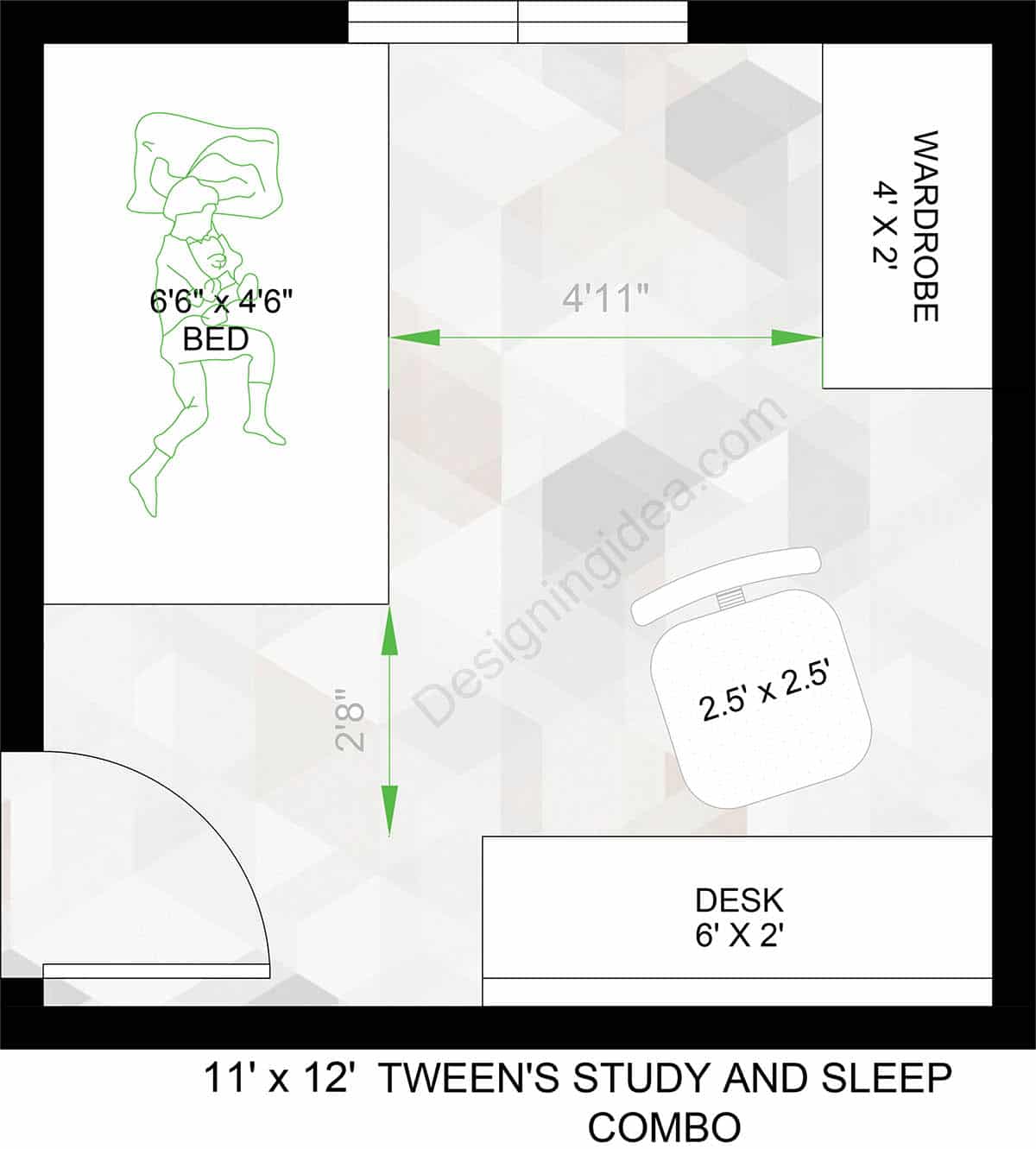
Floor Plan Details: This tween layout gives a growing kid a full‑size sleep zone and a serious study wall without crowding the room. A 4’6″‑wide x 6’6″ long bed sits along the left wall, leaving space for a 4′ × 2′ wardrobe on the opposite side. The entire bottom wall becomes a focused work and study area with a 6′ × 2′ desk and a chair that backs into the open center. The door swings in at the lower left and feeds directly into the central aisle, keeping circulation easy as it flows from entry → desk → bed/closet.
Dimensions:
- Room size: 11′ × 12′
- Bed (full/double footprint): 6’6″ × 4’6″
- Desk: 6′ × 2′
- Wardrobe: 4′ × 2′
- Clear aisle (bed to wardrobe): 4’11”
- Entry passage by door: 2’8″
- Approx. chair footprint/clearance: 2.5′ × 2.5′
Design Tips:
- Zone the desk for study + hobby. Use two rolling pedestals to separate study and play items.
- Add dimmable task lighting under the wall shelf. This creates surface light for the desktop.
- Add a bedside sconce. This is helpful for wind‑down reading at night.
- Use under‑bed drawers or a lift‑up platform bed. This will help free up the wardrobe for clothing.
- Mount a whiteboard above the desk. For teen schedules and ideas.
- Place a 5′ × 7′ low‑pile rug in the center. It can be used for lounging or working on crafts.
- Hang over‑door hooks. Utilize the space behind the door for jackets or zip-up sweatshirts.

